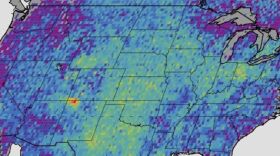In 2014, NASA announced they’d found that the largest plume of methane gas in North America was right here in New Mexico.
At the time, scientists didn’t know exactly where the methane was coming from – but now they’ve completed some research and published their findings.
Laura Paskus is an independent journalist who reports on the environment. She told KUNM’s Elaine Baumgartel that scientists discovered the methane plume using satellite imagery.
Paskus: Then they came to the Four Corners to figure out, ‘Ok, where is this methane coming from specifically?’ Last spring, they had aircraft between one and three kilometers above the ground’s surface, and then they had ground crews so they could use infrared technology to see where the methane was coming from and then the ground crew people could help them figure out exactly what’s down there.
KUNM: Folks were originally thinking, there’s a lot of oil and gas development up there, coal mining, cattle farms create methane. Landfills, wastewater treatment plants, all these produce methane. There was also talk about how the methane might have come from elsewhere, that weather patterns may have caused the gas to kind of settle in northwestern New Mexico. So, what did they find with their study?
Paskus: They were able to identify 250 emitters of methane and they found that 10 percent of those 250 were responsible for about half the methane emissions in the San Juan Basin.
KUNM: So who are these 25 top emitters then?
Paskus: They don’t list them in the report. I was kind of excited. I was hoping to see that to figure out exactly where they are and what’s happening. They don’t list those big emitters, but they mention that the emissions do come from leaky pipelines, leaky storage areas, natural vents in the coal beds, and a new gas processing facility was also identified.
KUNM: So, no cattle that we know of?
Paskus: Those were not listed among the…
KUNM: Landfills?
Paskus: Nope.
KUNM: Weather patterns?
Paskus: I didn’t see anything about weather patterns in the report.
KUNM: So what does this mean? It’s not surprising that the fossil fuel industry is the source of so much of this methane, I think, ok, kind of to be expected. But is this information useful beyond that? Is it going to change anything in the industry in New Mexico?
Paskus: I think it could. What I found really exciting about the report, which I’ve been waiting to read, is that they were able to identify a specific emitter or facility or leaky pipeline and then call up the operator and say, ‘hey, the storage tank is leaking’ or ‘this pipeline is leaking,’ and then the operator could go and fix it. There’s also mentioned in the report that they called state regulators. And so I think that’s a really exciting practical tool that we now have for scientists to identify who’s leaking and to fix it as quickly as possible. I would hope that that’s something that the energy industry itself would really embrace, as it’s not just methane contributing to global warming but it’s lost product as well.








